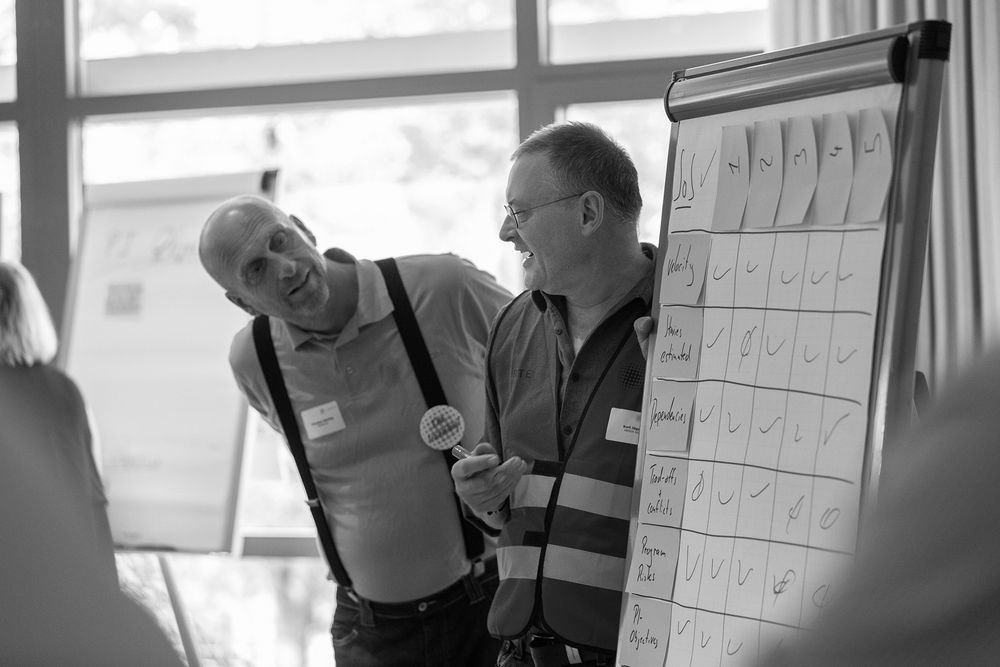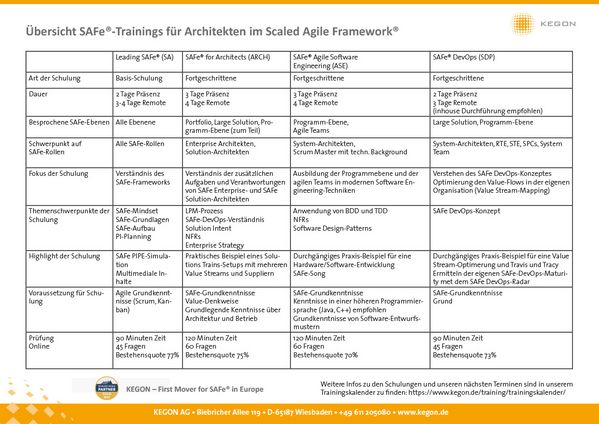
Which SAFe® training is right for architects in the Scaled Agile Framework®?
Compared to other agile frameworks (Scrum, Kanban, LeSS), the Scaled Agile Framework (SAFe®) defines three explicit architect roles at the different SAFe levels Portfolio, Large Solution and Essential SAFe to anchor the responsibility for value-oriented architecture and good quality of results and to promote the technical training of agile teams.
But which of the 12 SAFe training courses currently offered is the right one for the various prospective SAFe architects?
Below we have summarized the recommended trainings for SAFe architects in an overview. In fact, all 3 trainings are recommended for every architect, as the SAFe roles of the architect go far beyond the skills widely known as technical architectural skills - see also blog article https://www.kegon.de/en/knowledge/blog/wenn-architekten-auch-business-machen0/
In order to get a first overview of the SAFe framework, roles, processes and artifacts, the training "Leading SAFe" is recommended as a basic training for all parties involved in a SAFe implementation, i.e. also the prospective SAFe architects.
If the role of the architect is then more oriented towards the portfolio or IT strategy level, the "SAFe-for-Architect" training is recommended, especially for "strategic architects" in large companies.
System architects of a single Agile Release Train also take a lot of additional information with them for their role, but the training context is more oriented towards larger and more complex SAFe setups with several Agile Releases and larger Solution Trains.
The right training to ensure the technical quality in terms of the delivery of the teams and the actual SAFe product ("Solution") is "Agile Software Engineering (ASE)", as it addresses technical good practices for modern software development, especially the techniques Behaviour-Driven Design (BDD) and Test-Driven Design (TDD) as well as the technical XP practices included in SAFe.
For this course, participants should have rudimentary programming skills in a higher programming language.
If an organization has already started to establish SAFe and the first PI-Plannings have taken place, the main task (besides supporting the Agile Teams) is to optimize the value flow, which is exactly the content of the SAFe DevOps training.
In addition to all these knowledge transfer trainings, good communication between the architects and the other roles at their level is one of the most important success parameters for successful SAFe transformations:
- System Architect with Product Management and Release Train Engineer
- Solution architect with solution management and solution train engineer
- Enterprise architect with Lean Portfolio Management team and Enterprise Executives.
Learn more about these four SAFe trainings:
https://www.kegon.de/en/training/leading-safe-sa/
https://www.kegon.de/en/training/safe-for-architects-arch/
https://www.kegon.de/en/training/safe-agile-software-engineering-ase/
https://kegon.de/en/training/safe-devops-sdp/
Further information about the training courses and our next dates can be found in our training calendar: https://www.kegon.de/en/training/trainings-calendar/
Further information on all SAFe training courses can be found here: https://www.kegon.de/wissen/blog/welches-safe-training-ist-das-richtige-fuer-mich/
Weitere Informationen zu diesen vier SAFe-Trainings:
https://www.kegon.de/training/leading-safe-sa/
https://www.kegon.de/training/safe-for-architects-arch/
https://www.kegon.de/training/safe-agile-software-engineering-ase/
https://kegon.de/training/safe-devops-sdp/
Weitere Infos zu den Schulungen und unseren nächsten Terminen sind in unserem Trainingskalender zu finden: https://www.kegon.de/training/trainingskalender/
Weitere Infos zu allen SAFe-Trainings finden Sie hier: https://www.kegon.de/en/knowledge/blog/welches-safe-training-ist-das-richtige-fuer-mich0/



![[Translate to English:] [Translate to English:]](/fileadmin/_processed_/9/6/csm_etas-AdobeStock_900120821_a242a2d667.jpg)